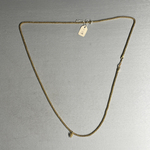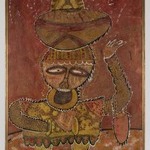4 Soho Eckstein Films [Johannesburg - Second Greatest City after Paris, 1989; Monument, 1990; Mine, 1991; Sobriety, Obesity and Growing Old, 1991]
William Kentridge
Contemporary Art
About this Brooklyn Icon
The Brooklyn Museum is commemorating its 200th anniversary by spotlighting 200 standout objects in its encyclopedic collection.
These films are from a series of 10 animated shorts made by South African multidisciplinary artist William Kentridge in the 1980s and ’90s. The films center on Soho Eckstein, a middle-aged businessman and property developer; Mrs. Eckstein, Soho’s lonely wife; and artist Felix Teitelbaum, Soho’s alter ego and Mrs. Eckstein’s lover. Through these complex fictional characters, Kentridge examines the political landscape and emotional layers of national trauma, from anger and despair to forgiveness and hope.
In a process that Kentridge aptly terms “Stone Age filmmaking,” he used a blank sheet of paper, horsehair brush, charcoal dust, stick of charcoal, and eraser to draft and smudge each drawing by hand. The acts of drawing, erasing, and meticulously recording the changes with stop-motion camerawork serve as metaphors for the precarious nature of time, memory, and histories experienced and imagined.
***
Gallery Label
The quest for gold has left an indelible mark on the social fabric of South Africa, resulting in a vast disparity of wealth. Set in the gold-mining area of Johannesburg, South Africa, Mine examines the sociopolitical effects of capitalism on the landscape and a society under an oppressive apartheid system. This inequity is visible in scenes of the destroyed cityscape and the suffering of Black and Brown men living and working in dire circumstances to satisfy the greed of a few. The film interrogates the various meanings of mine, including the physical act of mining, as well as the pronoun—a reference to the greed of the protagonist, who is based on a real-life mining magnate.
The Brooklyn Museum is commemorating its 200th anniversary by spotlighting 200 standout objects in its encyclopedic collection.
These films are from a series of 10 animated shorts made by South African multidisciplinary artist William Kentridge in the 1980s and ’90s. The films center on Soho Eckstein, a middle-aged businessman and property developer; Mrs. Eckstein, Soho’s lonely wife; and artist Felix Teitelbaum, Soho’s alter ego and Mrs. Eckstein’s lover. Through these complex fictional characters, Kentridge examines the political landscape and emotional layers of national trauma, from anger and despair to forgiveness and hope.
In a process that Kentridge aptly terms “Stone Age filmmaking,” he used a blank sheet of paper, horsehair brush, charcoal dust, stick of charcoal, and eraser to draft and smudge each drawing by hand. The acts of drawing, erasing, and meticulously recording the changes with stop-motion camerawork serve as metaphors for the precarious nature of time, memory, and histories experienced and imagined.
***
Gallery Label
The quest for gold has left an indelible mark on the social fabric of South Africa, resulting in a vast disparity of wealth. Set in the gold-mining area of Johannesburg, South Africa, Mine examines the sociopolitical effects of capitalism on the landscape and a society under an oppressive apartheid system. This inequity is visible in scenes of the destroyed cityscape and the suffering of Black and Brown men living and working in dire circumstances to satisfy the greed of a few. The film interrogates the various meanings of mine, including the physical act of mining, as well as the pronoun—a reference to the greed of the protagonist, who is based on a real-life mining magnate.
MEDIUM
Film transferred to HD video, Johannesburg (8:02); Monument (3:11); Mine (5:49); Sobriety (8:15)
DATES
1989–1991
DIMENSIONS
box: 5 × 17 × 17 in. (12.7 × 43.2 × 43.2 cm)
COLLECTIONS
Contemporary Art
ACCESSION NUMBER
2019.30.5
CREDIT LINE
Gift of The Carol and Arthur Goldberg Collection
PROVENANCE
Prior to 2019, provenance not yet documented; before July 2019, acquired by Barbara Gladstone Gallery, New York, NY; by July 2019, purchased from Barbara Gladstone Gallery by Arthur and Carol Goldberg of New York; October 23, 2019, gift of Arthur and Carol Goldberg to the Brooklyn Museum.
Provenance FAQ
EXHIBITIONS
MUSEUM LOCATION
This item is not on view
EDITION
Edition: 1/10 plus two Artist's Proofs
RECORD COMPLETENESS
Not every record you will find here is complete. More information is available for some works than for others, and some entries have been updated more recently. Records are frequently reviewed and revised, and we welcome any additional information you might have.






























